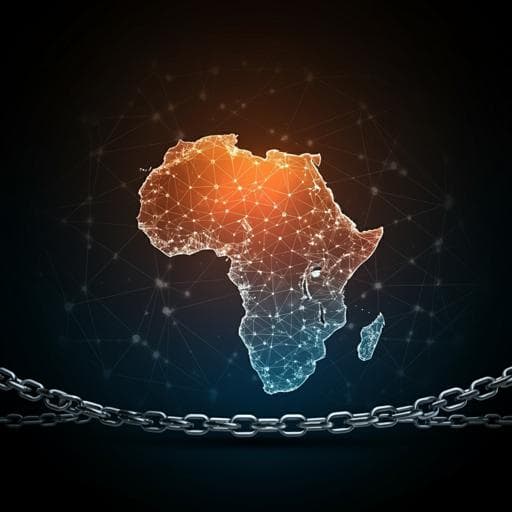
Economics
Unlocking Africa's development potential: insights from the perspective of global hierarchy and competition
F. Wang, J. Gao, et al.
This research by Fanglei Wang, Jianbo Gao, and Feiyan Liu examines the enduring economic challenges in Africa, highlighting the negative global hierarchy and the impacts of colonialism. By introducing the Revealed Comparative Wealth metric, the study suggests pathways for Africa's economic diversification and development potential.
~3 min • Beginner • English
Introduction
The paper addresses why many African countries remain relatively poor despite global scientific and technological advances. It questions the adequacy of GDP (or GDP per capita) growth as a sole indicator of development because positive growth can still imply falling behind the world average. The authors propose using revealed comparative wealth (RCW)—a country's GDP per capita relative to the world average—to evaluate Africa’s development dynamics and to investigate mechanisms underpinning persistent underdevelopment. They situate Africa within the "developing South" versus "industrialized North" context and note Africa’s shrinking shares of world GDP, trade, and investment over recent decades. The study aims to analyze temporal RCW patterns, economic coupling with advanced economies, positions within global value chains, and the roles of colonialism and neo-colonialism, and to derive policy recommendations for unlocking development potential.
Literature Review
The paper surveys extensive literature on drivers of economic development—capital, labor, human resources, education, technology, innovation, geography, policy, politics, democracy, and institutions (e.g., Acemoglu et al.; North; Krugman; Stiglitz and Weiss). African-focused studies highlight technology spillovers from FDI (Haddad & Harrison), governance and political freedom (Savvides), human capital and education (Keita), financial development and FDI (Assefa & Mollick; Mullings & Mahabir; Yimer), knowledge stocks and R&D in agriculture (Adetutu & Ajayi), and innovation (Hartwig). Other strands emphasize governance capacity (Fayissa & Nsiah), resource-rich and specific-country experiences (e.g., South Africa, Ghana), and regional unions. A contrasting body of work stresses complexity and heterogeneity in determinants (e.g., Frankel & Romer; Frankema & Van Waijenburg; Stiglitz; Hartmann & Pinheiro). Dependency and world-systems theories (Wallerstein; Caporaso; Angotti) and critiques (Ramirez-Faria; Amin) provide context for center-periphery dynamics and neo-colonial hierarchies. This mixed literature motivates an alternative, relative metric (RCW) and a coupling-based perspective.
Methodology
Data sources: World Bank data on GDP (current US$) and population for 1960–2020. The study covers 46 African countries with available data (Algeria, Benin, Botswana, Burkina Faso, Burundi, Cameroon, Cabo Verde, Central African Republic, Chad, Comoros, DR Congo, Republic of the Congo, Côte d’Ivoire, Egypt, Eswatini, Ethiopia, Gambia, Gabon, Ghana, Guinea, Guinea-Bissau, Kenya, Libya, Lesotho, Madagascar, Malawi, Mali, Mauritania, Mauritius, Morocco, Mozambique, Namibia, Niger, Nigeria, Rwanda, Senegal, Seychelles, Sierra Leone, South Sudan, Sudan, Tunisia, Togo, Uganda, Zambia, Zimbabwe). Nineteen advanced economies are included for comparison (USA, Japan, Israel, Austria, Belgium, Denmark, France, Finland, Germany, Greece, Ireland, Italy, Luxembourg, Netherlands, Norway, Portugal, Spain, Sweden, UK). International trade data (SITC 3-digit) are from UN Comtrade, with detailed analysis for 2019.
RCW metric: RCW is defined as the ratio between a country’s GDP per capita and the world average GDP per capita (equivalently, the ratio of the country’s share of world wealth to its share of world population). The study uses nominal GDP rather than PPP to reflect global purchasing power and capture business cycles and crises. RCW is dimensionless and tends to produce stationary time series, enabling correlation analyses across countries.
Coupling analysis and bipartite networks: Pairwise correlations are computed between RCW time series for African countries and the 19 advanced economies. A bipartite network is constructed: advanced economies along a vertical diameter and African countries on a circle; links correspond to correlations. For visualization, strong correlations are highlighted with thresholds (|corr| > 0.5): green for positive (>0.5), red for negative (<−0.5). Additional sub-networks center the UK and France, coloring links by correlation magnitude and sign, and marking former colonies.
Zipf–Mandelbrot law (ZML): For each year, RCW values across all countries are normalized (RCW*) and ranked; plots of RCW* versus rank (log–log) are fitted by ZML to characterize the global economic hierarchy. ZML is also applied to global trade value rankings across SITC 3-digit categories and to country rankings within selected categories.
Trade structure analysis: Using 2019 UN Comtrade SITC 3-digit export data (182 categories), the study ranks commodity categories by global trade value (log–log ZML), identifies categories with significant African contributions (e.g., 667, 681, 682, 841), and ranks countries by export values within selected categories (e.g., 732, 332, 841, 667) to infer African positions in global value chains.
Interpretive framework: Correlation signs are interpreted via value-chain positioning: strong negative correlations suggest downstream positioning relative to advanced economies; strong positive correlations suggest more competitive/parallel dynamics. The analysis also examines colonial and neo-colonial mechanisms (including profit allocation and market weaponization through imports, currency devaluation with IMF programs) in relation to maintaining the global hierarchy revealed by ZML.
Key Findings
- RCW trends and distributions:
- Many African countries’ RCW values have declined or flattened over decades; a subset (~1/3) shows first decreasing then flat RCW, indicating growth roughly tracking the world average after population adjustment (an “equilibrium”).
- Histograms (1970, 1990, 2010, 2020) show increases in the number of countries with very low RCW (e.g., ≤0.1) and with very high RCW; countries in [0.3–0.5] declined from 11 (1970) to 3 (1990) then rebounded to 7 (2010, 2020).
- Persistent low RCW (≤0.1) characterizes over 40% of African countries for more than three decades, implying large populations facing survival-level incomes.
- The difference between maximum and minimum RCW across (non-small) African countries declined from about 2.8 (1976) to just above 0.5 (2020), indicating convergence at low relative incomes.
- Coupling with advanced economies:
- Bipartite network analysis shows that the majority of African countries have RCW strongly negatively correlated (corr < −0.5) with one or more advanced economies, indicating opposite-phase coupling and downstream positioning on value chains.
- Detailed correlation tables (examples) show widespread negative correlations for large African economies (Egypt, Ghana, Kenya, Nigeria, South Africa) with many advanced countries; Ghana and Kenya exhibit especially numerous strong negatives.
- A small set (Seychelles, Mauritius, Botswana, Cabo Verde; Libya with caveats) shows strong positive correlations with several advanced economies, aligning with upward or above-average RCW trajectories.
- Country cases from RCW curves:
- Mauritius: RCW rose from ~0.4 (mid-1980s) to ~1 by ~2018, driven by diversification into ICT, tourism, finance, and higher value-added manufactures; added >10 advantageous export products (e.g., soaps, textile/leather machinery, telecom apparatus, travel goods, printed matter) since 1990.
- Botswana: Resource-rich (diamonds and other minerals) but RCW largely plateaued since 1990, not trending upward.
- Seychelles: Small population with RCW persistently above 1 since the 1990s (tourism, agriculture-based).
- Many others (e.g., Burkina Faso, CAR, Morocco, Niger) show flat RCW; others (e.g., Algeria, Ghana, Nigeria, South Africa; Egypt, Gambia, Kenya, Zimbabwe; Ethiopia, Rwanda, Tanzania, Uganda) generally downward or volatile.
- Global hierarchy via ZML:
- Annual global RCW rankings fit the Zipf–Mandelbrot law, defining a persistent global hierarchy; African countries cluster at the lower tail, evidencing inferior positions (with a few non-African low-RCW countries also present).
- Trade structure and value chains:
- Africa’s share of global exports is small: ~2.46% (2019) and ~2.14% (2020), while Africa’s population is ~18% of world total (2024).
- Most African countries rank low in global export value rankings within key categories (e.g., SITC 732 machinery; 332 refined petroleum; 841 clothing; 667 precious stones), signaling downstream roles; even top African performers (e.g., South Africa in 732, Egypt in 332) rank modestly globally.
- Mechanisms and external shocks:
- The primary mechanism for underdevelopment is the partition of labor and industrial structure differences placing African countries at the bottom of value chains, yielding negative RCW correlations with advanced economies and positive correlations among African peers (reflecting substitutable competition in similar exports).
- Colonial legacies set initial inferior conditions; neo-colonial dynamics (profit allocation favoring investors from wealthy nations, enforced imports of inputs, IMF-linked currency devaluations) help maintain or reinforce the hierarchy.
- “Cycle-induced” episodes: Africa’s relative improvements in 2000s coincide with advanced economies’ downturns (wars in Afghanistan/Iraq; Global Financial Crisis), consistent with opposite-phase coupling revealed by RCW.
Discussion
The findings directly address the research question by showing that relative development, captured by RCW, reveals dynamics obscured by raw GDP growth: many African economies have not kept pace with the world average after accounting for population. Strong negative RCW correlations with advanced economies imply systematic downstream positioning in global value chains, where gains are limited and cyclical dynamics in core economies propagate in opposite phase to many African economies. The ZML-based global hierarchy formalizes Africa’s inferior placement in the world distribution of economic power and purchasing capacity.
The analysis of trade structure corroborates the mechanism: African countries contribute small shares to high-value global exports and mainly occupy low-rank positions within major categories, with intra-African positive coupling reflecting competition in similar, lower value-added exports. The study connects these patterns to historical and contemporary structures, including colonial initial conditions and neo-colonial practices (profit allocation asymmetries, market weaponization via imports and currency devaluations tied to IMF programs), which together sustain the hierarchy and constrain upgrading.
Implications are twofold: (1) policy should target industrial diversification and movement into higher segments of value chains to reverse negative coupling; and (2) development assessments should adopt relative, globally-referenced metrics like RCW to detect whether countries are genuinely catching up. The observed “cycle-induced” improvements suggest that external shocks in advanced economies can temporarily improve Africa’s relative position, but sustainable convergence requires structural upgrading and more equitable profit-sharing arrangements.
Conclusion
The paper introduces RCW as a relative, largely stationary metric for assessing development, enabling coupling analyses that reveal over 30 African countries are strongly negatively correlated with advanced economies, and that many are trapped in flat RCW trajectories. Annual global RCW rankings follow a Zipf–Mandelbrot profile that defines a persistent global hierarchy, within which African countries largely occupy inferior positions. Trade evidence confirms downstream roles in value chains. Colonial histories and neo-colonial mechanisms (profit allocation skew, enforced imports, currency devaluations) contribute to maintaining this structure.
To unlock development potential, the authors recommend: diversifying economic activity; fostering creativity and capital accumulation; using foreign capital and partnering with multinationals more judiciously to secure better profit allocation; strengthening technological cooperation and technology transfer; developing indigenous manufacturing; enhancing bargaining in mineral extraction; dominating domestic capital markets; and avoiding unsustainable foreign debt. Learning from African countries with upward RCW and positive coupling (e.g., Mauritius, Seychelles, Botswana, Cabo Verde—contextualized by size and resource endowments) can guide pathways. Future research should reassess roles of FDI, trade, and governance at the individual-country level using approaches beyond regression-based averages, leveraging RCW’s properties to capture heterogeneous temporal dynamics.
Limitations
- Data limitations include missing or short time series for some countries (e.g., Libya before 1990), which can bias correlation assessments (e.g., spurious positives from short spans).
- The set of comparator advanced economies is limited to 19 countries; results may vary with a broader set.
- Correlation thresholds (e.g., |corr| > 0.5) and visualization choices in bipartite networks affect which linkages are emphasized.
- RCW is computed using nominal GDP (not PPP), prioritizing global purchasing power; while justified for studying international competition, findings may differ under PPP adjustments.
- Trade analysis focuses mainly on 2019 SITC 3-digit data; structural inferences may be sensitive to year choice and classification granularity.
- The study is primarily observational and interpretive; it does not employ causal identification strategies, and thus mechanisms (e.g., neo-colonial dynamics) are inferred rather than causally estimated.
Related Publications
Explore these studies to deepen your understanding of the subject.







